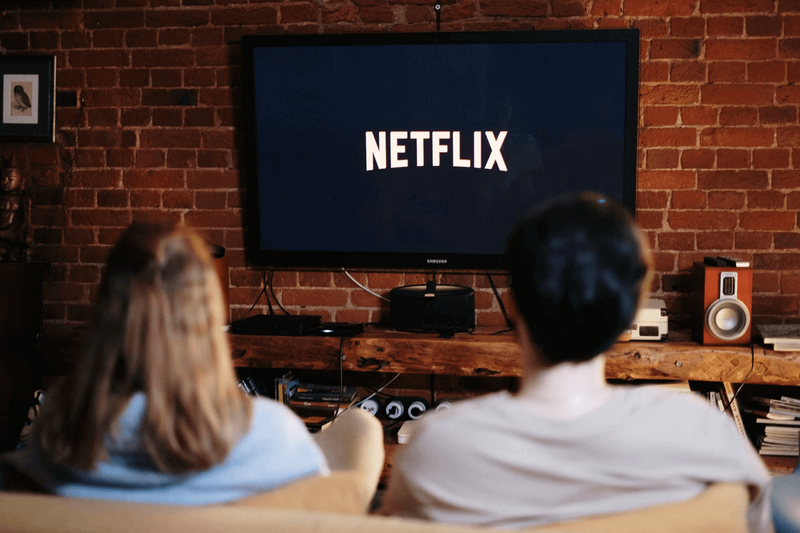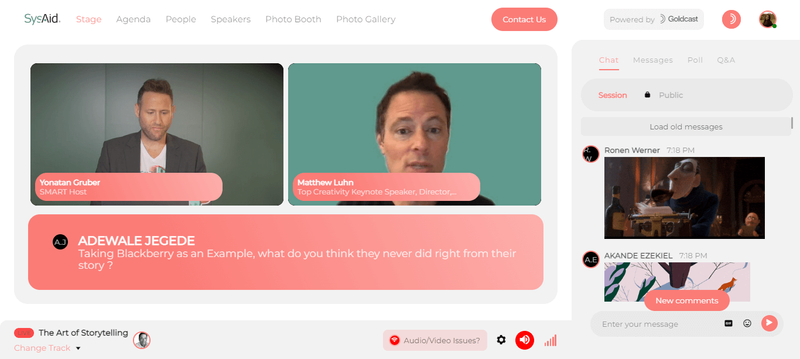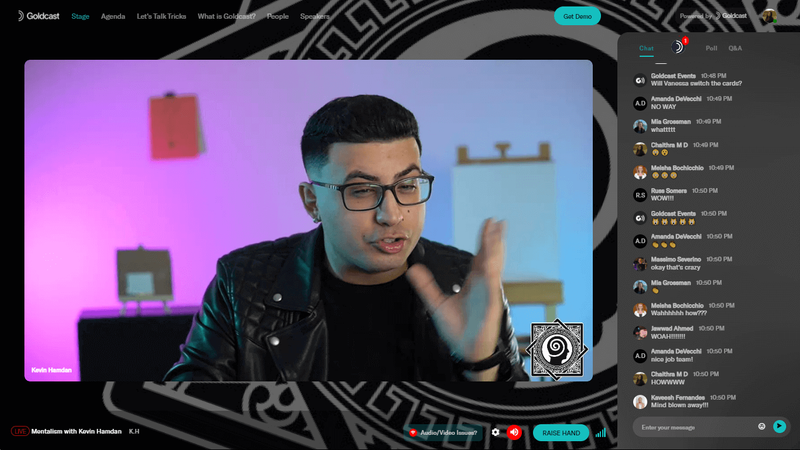Optimizing for Virtual Attention Span: 8 Tips to Capture and Keep Audience Attention

Maximize Your Marketing ROI
Join 10,000 other marketers already getting the best tips on running engaging events that boost pipeline and create raving fans.
There's an old Seinfeld episode (Season 3, Episode 11, to be exact) in which Jerry Seinfeld visits a rental car agency to pick up the car he's reserved—only to find they've run out of cars.
Understandably frustrated, Jerry remarks, "See, you know how to take the reservation. You don't know how to hold the reservation—and that's the most important part."
What's any of this got to do with virtual events? Well, think of the audience's attention span during your digital events like Jerry's reservation. It may be easy to take people's attention at first—but we need to know how to hold on to it to really make an impact.
The myth of decreasing attention span
Before we get started, let's clear up some misconceptions about dwindling attention spans. Maybe you've heard the chatter about how research shows the average attention span has dropped to a mere eight seconds?
It turns out that may not be as true as people think. According to some experts, paying attention is actually task-dependent, and there's no such thing as an "average" attention span.
This makes sense, right? You probably have no trouble sitting down and paying attention to your favorite TV shows or losing yourself in your favorite hobby!

This means that attention spans aren't really the problem—it's more that we need to make sure the task at hand is interesting enough to prevent people from getting distracted. There are more things vying for people's attention than ever before, so you'll have to keep this in mind as you develop your event experience.
Today, we'll talk about eight specific ways you can capture and keep people's attention during digital events. Let's get started!
1. Keep it succinct
TED-style talks have become quite famous over the years. Part of what makes them compelling—beyond the storytelling and insights, of course—is their short duration. TED Talks are 18 minutes long at max, and there’s logical reasoning behind this decision.
According to TED curator Chris Anderson, “The 18-minute length works much like the way Twitter forces people to be disciplined in what they write. By forcing speakers who are used to going on for 45 minutes to bring it down to 18, you get them to really think about what they want to say. What is the key point they want to communicate? It has a clarifying effect. It brings discipline.”
By forcing speakers who are used to going on for 45 minutes to bring it down to 18, you get them to really think about what they want to say. What is the key point they want to communicate?”
Event organizers can apply the same logic to digital events. It helps to break down your content into small chunks of microlearning sessions, followed by short breaks. People are working from home and bombarded with virtual meetings, so they'll appreciate the brevity. This also keeps the audience interested and engaged throughout the event.
💡 Tip: While there is no standard rule for optimal session length, try dividing single-speaker presentations into bursts of 20-minute mini-sessions. For panel presentations and multi-speaker presentations, you can extend them to 45-minute sessions. Learn why in our full B2B Webinar Benchmark Report.
2. Spice up your session format
Your sessions don’t have to follow the typical format of a presentation followed by Q&A. You have plenty of alternatives available to make things more interactive than that!
For example, instead of keeping the Q&A session at the end, you can invite questions from the audience throughout the session. You can just pin a chat message like, “Got questions for the presenter? Add them to the Q&A tab!” to keep the audience questions flowing in.

Or maybe you try kicking the session off with a short video clip. You can also break up your sessions by adding pre-recorded videos or commercials to connect with attendees in your brand voice.
No matter what you choose, you may want to communicate the format up front with attendees, so people know what to expect.
3. Refer to previous and upcoming sessions
Your sessions are unlikely to exist in a silo. Chances are you will touch upon a concept or two that have been or will be, discussed during some other session—whether that's in the current event, one that's happened already, or one that's scheduled in the future.
When this happens, make sure to call it out for attendees!
That means if you talk about a concept that links to something someone else will be talking about later, talk about that schedule and presenter. The event producer can also pin a comment in the chat box highlighting the session details.

Similarly, if you talk about a concept covered in a previous session, consider giving attendees a quick overview or summary so that everyone's on the same page.
Creating a linear experience for everyone not only helps break the monotony of just speaking about a topic, but it also keeps people engaged and on track with your digital events.
4. Push polls throughout the session
Polls are an incredible engagement tool; people love weighing in, and they give everyone a quick break. Plus, they work great as icebreakers too, which is something we really miss from face-to-face events!
You can kick-start virtual event engagement by starting the session with a poll. This is a good time to ask an overarching question, which will help you understand the general sentiment of the audience around the topic.

When planning your session, decide how many polls or questions you want to ask. Try to keep polls easy and straightforward to answer; save complicated questions for your post-event questionnaires when people have more time to think.
Lastly, whenever launching polls, let the speaker, moderator, or emcee announce the polls and share the instructions so people know how to participate.
5. Gamify engagement
Whenever you want to encourage certain behaviors, gamification is your friend.
Gamification lets you reward certain behaviors in the form of intrinsic value (a sense of achievement) or extrinsic rewards (leaderboard, reward points, etc.).
Gamification can be used throughout the event. For instance, you can incorporate leaderboards to boost session engagement. Do this by assigning people points for participating in surveys or asking questions.

Event organizers can also introduce interactive games (like puzzles, maps, word search, etc,) or even photobooths for longer breaks! This is not only fun, but also increases the chances people stick around for the rest of your virtual meetings.
Game on: Get more gamification ideas and inspiration for your next event!🎮
6. Keep "banner blindness" in mind
There's an advertising phenomenon called banner blindness, which basically means people often miss on-screen banners and instructions.
Keep this in mind for your events! If you want people to take an action, don't just present it to them in banner format. Instead, also have a speaker verbally instruct the audience on what to do.
You can also design the lower thirds and tickers to stand out during your online meeting. This will help your text feature more prominently. Or, try using the chat section to push out instructions or announcements—people are less likely to miss the chat notifications that pop up.
7. Build in live entertainment breaks
People come to digital events to learn, but also to have fun! Try incorporating some entertainment sessions throughout your virtual event. Some examples include: live music parties, standup comedy sets, mixology sessions, and more.
At Goldcast, we've experimented in virtual settings with a live DJ playing song requests before an event and during breaks. We also had a mentalist show off to our audience before the event kicked off.

And guess what? People loved both of those acts!
The key to success is that before the event, we trained both the DJ and mentalist on our platform. That way, they knew exactly how to use Goldcast and shuffle between multiple camera angles to deliver a kickass performance.
8. Announce giveaways throughout the event
Entertainment is one thing, but people also love to win tangible rewards. We've tried raffles, swags, and large giveaways, and we've found they all help us drive attendee registrations and attendance.
You can also incentivize gifts by combining them with gamification. Gamification + Giveaways = Max engagement!
Instead of announcing giveaways at the end of the event, we keep talking about them throughout the event, so the audience stays around. Try it out for yourself! You can flash the giveaway announcement on stage and have the emcee tease the audience to amp up the excitement, too.
You can even take it a step further and make it personalized with smart gifting. That approach is all about identifying different moments in the buyer’s journey and using data to give away intentional gifts.
🎁 New to gifting? Learn how to enhance the event experience through smart gifting.
Keeping the audience intrigued is totally doable
Now you know how to keep your audience focused on the task at hand—in other words, your awesome event! By keeping these tips in mind, you'll be able to keep people's attention focused and help them stay engaged throughout your online meeting.
Let us know how these ideas work for you!

Transform Your Video Marketing with AI
Stay In Touch
Platform
Resources
© 2025 Copyright Goldcast, Inc. All rights reserved.





 Upcoming Events
Upcoming Events Event Series
Event Series On-Demand Events
On-Demand Events

